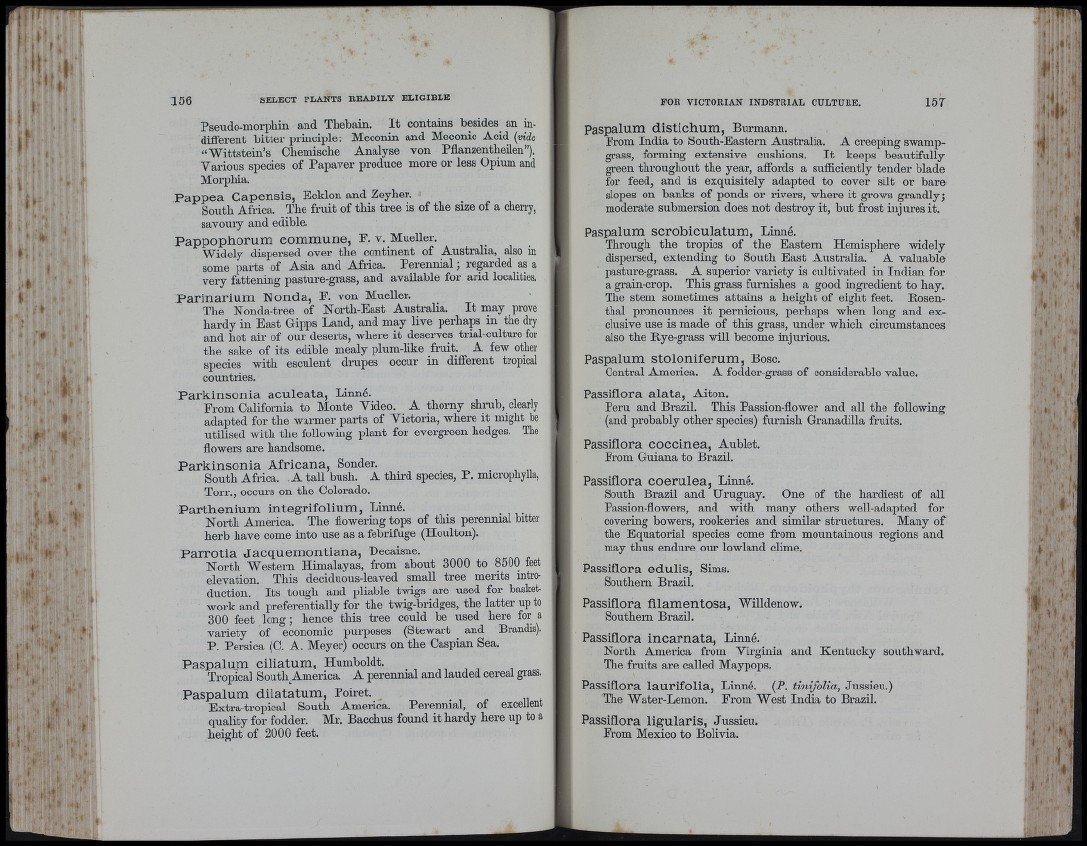
5! ' ■ • iÌ iI ' I
s u h : !
■ j I-;
c
h
t *
* »
156 SELECT PLANTS READILY ELIGIBLE
Pseudo-morphin and Thebain. I t contains besides an indifferent
bitter principle: Meconin and Meconic Acid [vide
“Wittstein’s Chemische Analyse von Pflanzentheilen”).
Various species of Papaver produce more or less Opium and
Morphia.
Pappea Capensis, Ecklon and Zeyher.
South Africa. Tbe fruit of tbis tree is of the size of a cherry,
savoury and edible.
P a p p o p h o r u m eommune, F. v. Mueller.
Widely dispersed over the continent of Australia, also in
some parts of Asia and Africa. Perennial ; regarded as a
very fattening pasture-grass, and available for arid localities.
Parinarium Nonda, E. von Mueller.
The Nonda-tree of North-East Australia. I t may prove
bardy in East Gipps Land, and may live perhaps in the dry
and hot air of our deserts, where it deserves trial-culture for
the sake of its edible mealy plum-like fruit. A few other
species with esculent drupes occur in different tropical
countries.
Parkinsonia aculeata, Linné. ,
From California to Monte Video. A thorny shrub, clearly
adapted for the warmer parts of Victoria, where it might be
utilised with the following plant for evergreen hedges. The
flowers are handsome.
Parkinsonia Africana, Sonder. _
South Africa. A tall bush. A third species, P. microphylla,
Torr., occurs on the Colorado.
Parthenium integrifolium, Linné.
North America. The fiowering tops of this perennial hitter
herb have come into use as a febrifuge (Houlton).
Parrotia Jacquemontiana, Decaisne.
North Western Himalayas, from about 3000 to 8500 feet
elevation. This deciduous-leaved small tree merits introduction.
Its tough and pliable twigs are used for basket-
work and preferentially for tbe twig-bridges, the latter up to
300 feet long ; hence tbis tree could be used here for a
variety of economic purposes (Stewart and Brandis).
P. Persica (C. A. Meyer) occurs on the Caspian Sea.
Paspalum ciliatum, Humboldt.
Tropical South America. A perennial and lauded cereal grass.
Paspalum dilatatum, Poiret.
Extra-tropical South America. Perenmal, of excellent
quality for fodder. Mr. Bacchus found it hardy here up to a
height of 2 0 0 0 feet.
FOR VICTORIAN INDSTRIAL CULTURE. 157
P a sp a lum d i s t i c h u m , Burmann.
From India to South-Eastern Australia. A creeping swamp-
grass, forming extensive cushions. I t keeps beautifully
green throughout the year, affords a sufficiently tender blade
for feed, and is exquisitely adapted to cover silt or bare
slopes on banks of ponds or rivers, where it grows grandly;
moderate submersion does not destroy it, but frost injures it.
Pa sp a lum s c r o b ic u la tu m , Linné.
Through the tropics of the Eastern Hemisphere widely
dispersed, extending to South East Australia. A valuable
pasture-grass. A superior variety is cultivated in Indian for
a grain-crop. This grass furnishes a good ingredient to hay.
The stem sometimes attains a height of eight feet. Rosenthal
pronounces it pernicious, perhaps when long and exclusive
use is made of this grass, under which circumstances
also the Rye-grass will become injurious.
Paspalum stoloniferum, Bose.
Central America. A fodder-grass of considerable value.
Passiflora alata, Aiton.
Peru and Brazil. This Passion-flower and all the following
(and probably other species) furnish Granadilla fruits.
Passiflora coccinea, Aublet.
From Guiana to Brazil.
Passiflora coerulea, Linné.
South Brazil and Uruguay. One of the hardiest of all
Passion-flowers, and with many others well-adapted for
covering bowers, rookeries and similar structures. Many of
the Equatorial species come from mountainous regions and
may thus endure our lowland clime.
Passiflora e d u l is , Sims.
Southern Brazil.
Passiflora filamentosa, Willdenow.
Southern Brazil.
Passiflora incarnata, Linné.
North Ameiùca from Virginia and Kentucky southward.
The fruits are called Maypops.
Passiflora laurifolia, Linné. (P. tinifolia, Jussieu.)
The Water-Lemon. From West India to Brazil.
Passiflora ligularis, Jussieu.
From Mexico to Bolivia.
I . .
11 ::
1 1